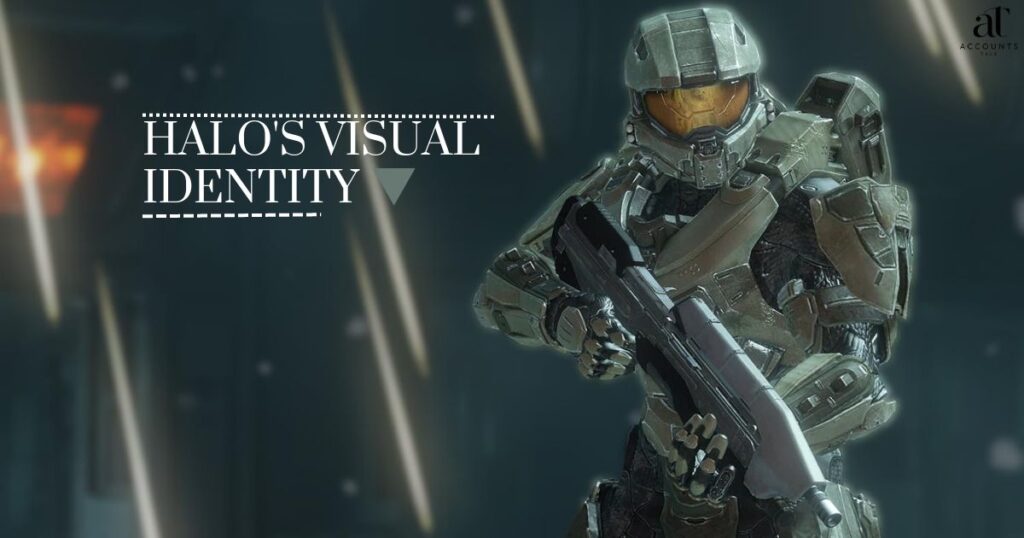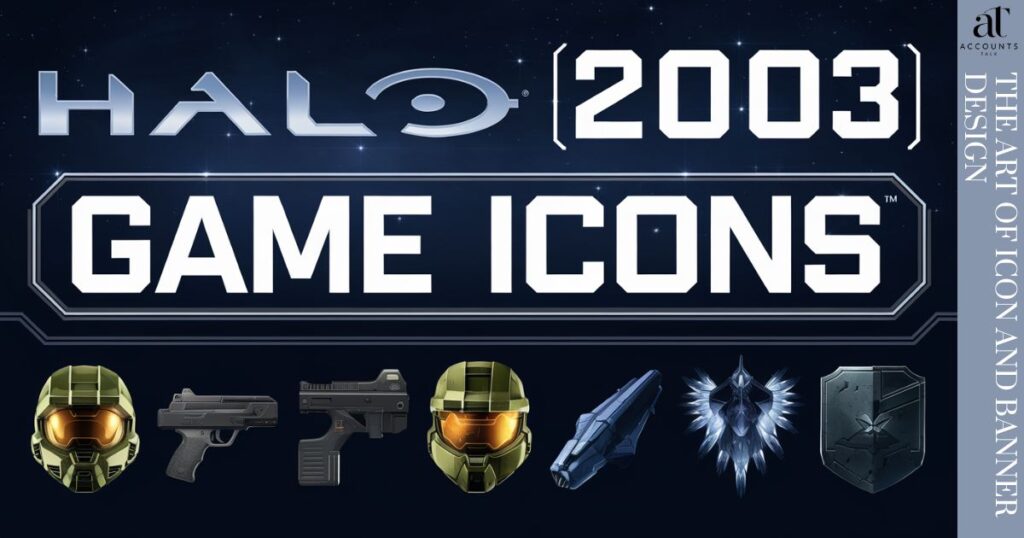In the vast universe of gaming, few titles have left as indelible a mark as Halo (2003). Released for the Xbox console, this groundbreaking first-person shooter from Bungie Studios didn’t just redefine its genre—it created a whole new galaxy of visual storytelling through its innovative use of game icons and banners.
Let’s dive deep into the world of Halo (2003) and explore how its iconic imagery shaped not just the game, but an entire gaming culture.
The Birth of a Legend: Halo’s Visual Identity

When Bungie Studios unleashed Halo: Combat Evolved in 2001, they weren’t just launching a game—they were igniting a revolution. By 2003, Halo had become synonymous with cutting-edge gameplay and immersive storytelling. But it was the game’s visual elements, particularly its icons and banners, that truly set it apart in the crowded field of first-person shooters.
Master Chief: The Face of a Franchise
At the heart of Halo’s visual identity stands the indomitable Master Chief. His Spartan armor, with its distinctive green hue and reflective gold visor, became an instant icon. This wasn’t just a character design—it was a symbol of heroism, a beacon of hope in the face of the overwhelming Covenant threat.
The Master Chief’s helmet, in particular, emerged as the quintessential Halo icon. Its sleek lines and futuristic design encapsulated the game’s blend of military grit and sci-fi wonder. Designers at Bungie Studios poured countless hours into perfecting every curve and contour, ensuring that this single image could convey the essence of the entire Halo universe.
Covenant Iconography: The Face of the Enemy
On the flip side, the Covenant’s alien aesthetic provided a stark contrast to the human elements of the game. The purple and blue hues associated with Covenant technology, from their sleek ships to their energy weapons, became instantly recognizable. Covenant icons, with their curved, almost organic shapes, hinted at a completely alien culture and technology.
These visual cues weren’t just for show—they played a crucial role in gameplay. Players could instantly identify friend from foe, human tech from alien artifacts, all thanks to the careful design choices made by Bungie’s artists.
Navigating the Ring World: Icons in Gameplay
Halo (2003) didn’t just use its icons for aesthetics—they were integral to the gameplay experience. From weapon selection to map navigation, icons guided players through the vast landscapes of the Halo ring worlds.
Weapons and Equipment: A Visual Arsenal
Each weapon in Halo’s diverse arsenal had its own unique icon. These weren’t just menu graphics—they were designed to be instantly recognizable in the heat of battle. The iconic shape of the Assault Rifle, the menacing silhouette of the Covenant Energy Sword, or the distinctive outline of a fragmentation grenade—each icon told a story and served a purpose.
Here’s a quick look at some of the most memorable weapon icons from Halo (2003):
| Weapon | Icon Description | Faction |
| Assault Rifle | Sleek, elongated shape with a distinctive stock | UNSC |
| Plasma Pistol | Rounded, organic form with a glowing center | Covenant |
| Sniper Rifle | Long, angular design with a prominent scope | UNSC |
| Energy Sword | Curved, dual-bladed silhouette | Covenant |
| Rocket Launcher | Bulky, rectangular shape with twin barrels | UNSC |
These icons didn’t just look cool—they conveyed crucial information about each weapon’s function and origin, allowing players to make split-second decisions in the midst of frantic firefights.
Mapping the Battlefield: Navigation Icons
In Halo’s sprawling environments, getting lost could mean game over. That’s where the game’s navigation icons came into play. Whether you were tracking objectives, locating teammates, or finding your way back to base, these simple yet effective markers were your guide through the chaos of combat.
The design philosophy behind these icons was simple: clarity and visibility. They needed to be instantly recognizable against any background, whether you were in the lush forests of a Halo installation or the metallic corridors of a Covenant ship.
Banners: More Than Just Decoration
While icons guided players within the game, banners served as gateways to the Halo universe itself. These larger, more elaborate visual elements played a crucial role in marketing, community building, and expanding the game’s narrative beyond the confines of the Xbox console.
Promotional Banners: Selling a Universe
Halo (2003)’s promotional banners were masterclasses in visual storytelling. They didn’t just advertise a game—they offered glimpses into an entire universe. Sweeping vistas of Halo installations hanging in space, intense firefights between UNSC forces and Covenant invaders, and of course, the towering figure of Master Chief at the center of it all.
These banners, plastered across websites, adorning the walls of gaming stores, and dominating gaming conventions, did more than generate hype. They set expectations, promising players not just a game, but an epic sci-fi odyssey.
Online Banners: Building a Community
As online gaming communities grew, so did the importance of virtual banners. Halo (2003) leveraged these digital spaces to foster a sense of belonging among its players. Clan banners, tournament announcements, and community event promotions all used the iconic visual language established by the game.
These online banners served as rally points for the Halo community, uniting players across the globe under the banner of the UNSC or their favorite multiplayer emblem.
The Art of Icon and Banner Design

Creating the icons and banners for Halo (2003) was no small feat. It required a delicate balance of artistic vision, technical expertise, and a deep understanding of the game’s lore and gameplay mechanics.
From Concept to Console: The Design Process
The journey of a Halo icon or banner typically began with concept sketches. Artists at Bungie Studios would pour over lore documents, gameplay mechanics, and marketing briefs to distill complex ideas into simple, striking visuals.
From there, the process moved to digital mockups. Using cutting-edge software tools, designers would refine their concepts, experimenting with colors, shapes, and compositions. The goal was always to create something that was not just visually appealing, but also functional and meaningful within the context of the game.
Rendering Reality: Technical Challenges
Bringing these designs to life in the game engine presented its own set of challenges. The Xbox console, while powerful for its time, still had limitations. Icons and banners needed to be crisp and recognizable even at low resolutions, and they had to load quickly to maintain the game’s frenetic pace.
This is where advanced rendering techniques came into play. Bungie’s technical artists worked tirelessly to optimize each visual element, ensuring that Halo’s icons and banners looked great without compromising the game’s performance.
Beyond the Game: Cultural Impact
The impact of Halo (2003)’s icons and banners extended far beyond the gaming world. They became part of the broader cultural lexicon, recognizable even to those who had never picked up an Xbox controller.
Fan Art and Cosplay: Community Creativity
The distinctive visual style of Halo sparked a creative explosion in the fan community. Artists around the world produced stunning fan art, reimagining Halo’s icons and banners in new and exciting ways. Cosplayers brought the game to life, crafting intricate Spartan armor and Covenant costumes, often using the game’s iconic imagery as reference.
Merchandise and Memorabilia: Owning a Piece of the Universe
Halo’s icons and banners found their way onto all manner of merchandise and collectibles. T-shirts emblazoned with the UNSC logo, posters featuring panoramic views of Halo installations, even replica Energy Swords—fans could surround themselves with tangible pieces of the Halo universe.
The Future of Icons and Banners in Gaming
As we look to the future, the legacy of Halo (2003)’s icons and banners continues to influence game design and marketing strategies. With the advent of new technologies, we’re seeing exciting developments in how games present their visual identities.
Virtual and Augmented Reality: A New Dimension
Virtual reality (VR) and augmented reality (AR) are opening up new possibilities for immersive gaming experiences. Imagine Halo’s iconic weapons floating in 3D space, or Covenant banners projected onto real-world environments. These technologies have the potential to bring game icons and banners into our world in ways we’ve never seen before.
AI and Machine Learning: Adaptive Iconography
Artificial intelligence (AI) and machine learning (ML) are set to revolutionize how we interact with game icons and banners. Imagine icons that adapt to your playstyle, or banners that change based on your achievements and preferences. These technologies could create truly personalized visual experiences for each player.
Conclusion: The Enduring Legacy of Halo’s Visual Language
Halo (2003)’s icons and banners were more than just pretty pictures—they were the visual building blocks of an entire universe. They guided players through alien worlds, united a global community, and left an indelible mark on gaming culture.
As the Halo franchise continues to evolve, its iconic visual language remains a touchstone for both developers and fans. It’s a reminder of the power of thoughtful design, and how a simple image can capture the imagination of millions.
Whether you’re a long-time Halo veteran or a newcomer to the series, take a moment to appreciate the artistry behind those familiar icons and banners. They’re not just part of a game—they’re part of gaming history.
Frequently Asked Questions
What are the icons in Halo Infinite?
Halo Infinite features various icons representing weapons, equipment, and objectives. Notable examples include the Grappleshot, Threat Sensor, and player emblems for customization.
How many Halos are there in the Halo games?
Throughout the Halo series, seven Halo rings have been prominently featured. However, the number of installations mentioned in lore totals twelve.
MorePost:

My work is dedicated to helping individuals navigate the financial world with confidence and achieve their financial goals. Follow me for practical tips and advice on all things finance.
